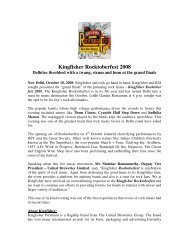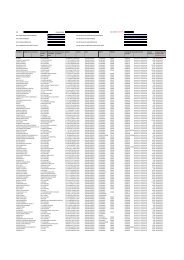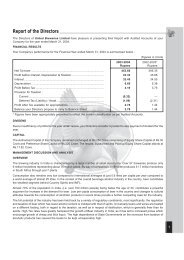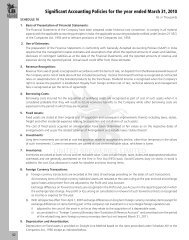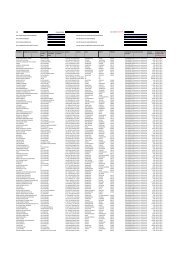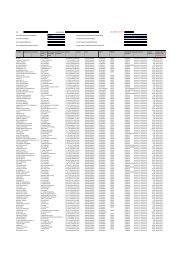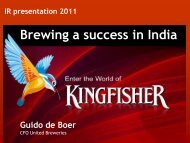Annual Report 2009-10 - United Breweries Limited
Annual Report 2009-10 - United Breweries Limited
Annual Report 2009-10 - United Breweries Limited
You also want an ePaper? Increase the reach of your titles
YUMPU automatically turns print PDFs into web optimized ePapers that Google loves.
Significant Accounting Policies for the year ended March 31, 20<strong>10</strong> (contd.)Rs. in Thousandsb) With retrospective effect from April 1, 2007 exchange differences on long term foreign currency monetary items (exceptfor exchange differences on items forming part of the company’s net investment in a non-integral foreign operation),are(i) adjusted to the cost of the asset in so far as they relate to the acquisition of a depreciable asset;(ii) accumulated in a “Foreign Currency Monetary Item Translation Difference Account” and amortised over the periodof the related long term foreign currency monetary item but not beyond March 31, 2011.9. Depreciation and amortisation:Depreciation on fixed assets is provided on Straight Line Method based on the rates prescribed under Schedule XIV to theCompanies Act, 1956 except as indicated below:a) Plant and Machinery are depreciated at the rate of <strong>10</strong>.34%. Further, depreciation is provided at higher rates in respectof certain specific items of plant and machinery having lower useful life based on technical evaluation carried out by themanagement.b) Assets acquired on amalgamation (where original dates of acquisition are not readily available), are depreciated over theremaining useful life of the assets as certified by an expert.Cost of Goodwill arising on amalgamation is amortised over a period of 5 years.Cost of Leasehold Land is amortised over the period of lease.Assets individually costing less than Rs.5 are depreciated fully in the year of purchase.<strong>10</strong>. Employee Retirement benefits:(i) Defined-contribution plans:Contributions to the Employees’ Provident Fund, Superannuation Fund, Employees’ State Insurance and Employees’Pension Scheme are as per statute and are recognised as expenses during the period in which the employees performthe services.(ii) Defined-benefit plans:Liability towards gratuity is determined on actuarial valuation using the Projected Unit Credit Method at the balancesheet date. Actuarial Gains and Losses are recognised immediately in the Profit and Loss Account.(iii) Other long term employee benefits:Liability towards leave encashment and compensated absences are recognised at the present value based on actuarialvaluation at each balance sheet date.(iv) Short term employee benefits:Undiscounted amount of liability towards earned leave, compensated absences, performance incentives etc. arerecognised during the period when the employee renders the services.11. Taxation:Current tax is determined as per the provisions of the Income Tax Act, 1961.Deferred tax is recognised, on timing differences, being the difference between taxable income and accounting income thatoriginate in one period and are capable of reversal in one or more subsequent periods. Deferred tax assets are not recognisedunless there is virtual certainity that sufficient future taxable income will be available against which such deferred tax assetscan be realised.Fringe Benefit Tax is determined at current applicable rates on expenses falling within the ambit of “Fringe Benefit” as definedunder Income Tax Act, 1961.12. Earnings per share:<strong>Annual</strong>ised earnings/ (loss) per equity share (basic and diluted) is arrived at based on ratio of profit/ (loss) attributable toequity shareholders to the weighted average number of equity shares.13. Impairment of Assets:At each Balance Sheet date, the Company assesses whether there is any indication that assets may be impaired. If any suchindication exists, the Company estimates the recoverable amount. If the carrying amount of the assets exceeds its recoverableamount, an impairment loss is recognised in the accounts to the extent the carrying amount exceeds the recoverableamount.7014. Provisions, Contingent Liabilities and Contingent Assets:Provisions are recognised when the company has a present obligation as a result of past events, for which it is probablethat an outflow of resources embodying economic benefits will be required to settle the obligation and a reliable estimateof the amount can be made. Provisions are reviewed regularly and are adjusted where necessary to reflect the current bestestimates of the obligation. When the company expects a provision to be reimbursed, the reimbursement is recognised asa separate asset, only when such reimbursement is virtually certain.A disclosure for contingent liability is made where there is a possible obligation or present obligation that may probably notrequire an outflow of resources.




